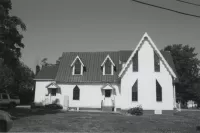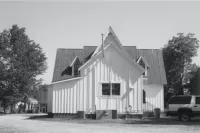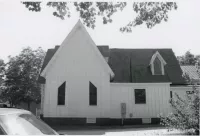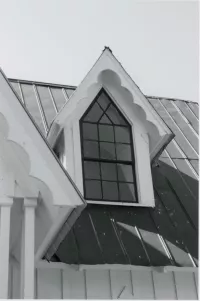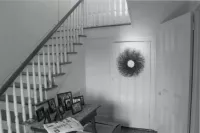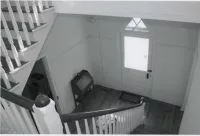Share what you know,
and discover more.
Share what you know,
and discover more.
May 15, 2008
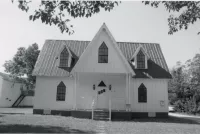
-

- Charmaine Bantugan
National Register of Historic Places - Ivey-Ellington House
Statement of Significance: The Ivey-Ellington House is locally significant under Criterion C for architecture with a period of significance in c. 1870. A rare example of Gothic Revival cottage architecture in Wake County, the house epitomizes the style with its steeply pitched roof and gables, board-and-batten siding, and pointed arch windows. It illustrates a national style and architectural movement in the context of a growing railroad town in the last decades of the nineteenth century. Furthermore, it shows the influence of pattern books and confirms the flow of ideas along rail lines from urban centers to rural areas. Context 2, "Civil War, Reconstruction, and a Shift to Commercial Agriculture (1861- 1885)", pages 30-46 in "Historic and Architectural Resources of Wake County, North Carolina, ca. 1770-1941" (MPDF) provides the historic context for the construction of the Ivey-Ellington House. The locally significant Ivey-Ellington House falls under Property Type 3B, "Houses Built between the Civil War and World War I," pages 131-136, which provides the architectural context. Houses in Wake County are significant as reflections of the architectural trends that reached the county and the choices and adaptations that people made in terms of architectural design and style. Additional architectural context and historical information specific to the house is included herein. According to the registration requirements on pages 141-142 of the MPDF, individual houses in Wake County must retain a high level of architectural integrity to be considered individually eligible for the National Register of Historic Places under criterion C for architecture. The Ivey-Ellington House is the best remaining example of Gothic Revival domestic architecture in the county. It has nearly all of its original exterior finishes with a reconstructed front porch in keeping with the Gothic Revival style. The interior arrangement remains intact, with original floors, trim, and windows.
National Register of Historic Places - Ivey-Ellington House
Statement of Significance: The Ivey-Ellington House is locally significant under Criterion C for architecture with a period of significance in c. 1870. A rare example of Gothic Revival cottage architecture in Wake County, the house epitomizes the style with its steeply pitched roof and gables, board-and-batten siding, and pointed arch windows. It illustrates a national style and architectural movement in the context of a growing railroad town in the last decades of the nineteenth century. Furthermore, it shows the influence of pattern books and confirms the flow of ideas along rail lines from urban centers to rural areas. Context 2, "Civil War, Reconstruction, and a Shift to Commercial Agriculture (1861- 1885)", pages 30-46 in "Historic and Architectural Resources of Wake County, North Carolina, ca. 1770-1941" (MPDF) provides the historic context for the construction of the Ivey-Ellington House. The locally significant Ivey-Ellington House falls under Property Type 3B, "Houses Built between the Civil War and World War I," pages 131-136, which provides the architectural context. Houses in Wake County are significant as reflections of the architectural trends that reached the county and the choices and adaptations that people made in terms of architectural design and style. Additional architectural context and historical information specific to the house is included herein. According to the registration requirements on pages 141-142 of the MPDF, individual houses in Wake County must retain a high level of architectural integrity to be considered individually eligible for the National Register of Historic Places under criterion C for architecture. The Ivey-Ellington House is the best remaining example of Gothic Revival domestic architecture in the county. It has nearly all of its original exterior finishes with a reconstructed front porch in keeping with the Gothic Revival style. The interior arrangement remains intact, with original floors, trim, and windows.
May 15, 2008
National Register of Historic Places - Ivey-Ellington House
Statement of Significance:The Ivey-Ellington House is locally significant under Criterion C for architecture with a period of significance in c. 1870. A rare example of Gothic Revival cottage architecture in Wake County, the house epitomizes the style with its steeply pitched roof and gables, board-and-batten siding, and pointed arch windows. It illustrates a national style and architectural movement in the context of a growing railroad town in the last decades of the nineteenth century. Furthermore, it shows the influence of pattern books and confirms the flow of ideas along rail lines from urban centers to rural areas.
Context 2, "Civil War, Reconstruction, and a Shift to Commercial Agriculture (1861- 1885)", pages 30-46 in "Historic and Architectural Resources of Wake County, North Carolina, ca. 1770-1941" (MPDF) provides the historic context for the construction of the Ivey-Ellington House. The locally significant Ivey-Ellington House falls under Property Type 3B, "Houses Built between the Civil War and World War I," pages 131-136, which provides the architectural context. Houses in Wake County are significant as reflections of the architectural trends that reached the county and the choices and adaptations that people made in terms of architectural design and style. Additional architectural context and historical information specific to the house is included herein.
According to the registration requirements on pages 141-142 of the MPDF, individual houses in Wake County must retain a high level of architectural integrity to be considered individually eligible for the National Register of Historic Places under criterion C for architecture. The Ivey-Ellington House is the best remaining example of Gothic Revival domestic architecture in the county. It has nearly all of its original exterior finishes with a reconstructed front porch in keeping with the Gothic Revival style. The interior arrangement remains intact, with original floors, trim, and windows.
Posted Date
Aug 31, 2023
Historical Record Date
May 15, 2008
Source Name
National Register of Historic Places
Source Website
Delete Story
Are you sure you want to delete this story?


